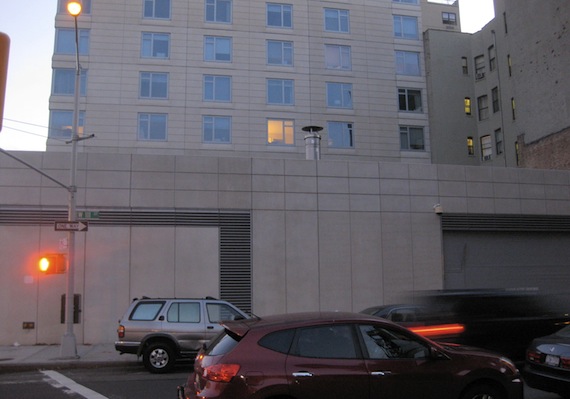
Get your cameras ready, Streetsbloggers. It's time to show Department of City Planning Director Amanda Burden what city-mandated parking garages are doing to the streets in your neighborhood.
In most of New York, it's illegal to build anything of a certain size without a certain amount of parking, thanks to 1960s-era mandates in the city zoning code. Despite ample research showing that parking minimums encourage car ownership and cause traffic, DCP claims otherwise and clings to the position that these mandates are necessary.
Traffic isn't the only cost of parking minimums, and under Burden DCP has at least acknowledged two other important ways they harm the city. Parking minimums increase the cost of housing, as the commissioner has stated, and parking on the ground floor erodes the pedestrian environment.
In some areas, DCP is beginning to rewrite the city's archaic zoning regulations to try and prevent parking from taking the place of ground-floor retail, lobbies, stoops, and other uses that connect buildings to the sidewalk. On Brooklyn's Fourth Avenue, where a 2003 rezoning led to a wave of development with ground floors dominated by ventilation ducts and even surface parking, DCP reversed course. In June, the department put out new rules forbidding curb cuts across the sidewalk, barring parking along the ground floor street frontage and encouraging retail uses. A draft rewrite of the parking regulations for much of Manhattan would eliminate a key incentive to build ground floor parking. In these select locations, Amanda Burden is making good on her widely-touted commitment to quality urban design.
Most of the city isn't so lucky, however. In Upper Manhattan and the outer boroughs, parking is required in new developments. In practice, because developers often find it impractical to build underground parking, that often means the city is reserving ground floors for parking. Instead of new development fostering an engaging public realm, pedestrians encounter blank walls and curb cuts. The good news is that DCP is in the process of revising parking regulations for the "inner ring" of neighborhoods around the Manhattan core, which presents an excellent opportunity to stop forcing these dead spaces on neighborhoods everywhere.
Writing about parking regulations can get dry, so Streetsblog is going to start making the case visually. We need your help for our new photo series: "Pedestrian Burdens."
Send us pictures of buildings in your neighborhood where parking harms pedestrian space, whether it's a ground-floor garage, an egregious curb cut, or an ugly surface lot. Bonus points for buildings covered by parking minimums (larger buildings in Upper Manhattan or the other four boroughs) and built during the Bloomberg administration. Email your photos to tips@streetsblog.org and make sure to include the address of the buildings. We'll feature the best on Streetsblog, building a visual case for Amanda Burden and DCP to act decisively on this critical urban design issue.
We're starting with three of our own. The photo at the top of the post is from 1 Morningside Drive. That blank wall contains a garage with 148 parking spots, right at ground level.
On that site, on the north side of 110th Street, developer AvalonBay was required to provide a space for 50 percent of the building's 295 units. It didn't build a single parking spot beyond what was required by law. Had the same building gone up literally across the street, it would have been subject to parking maximums, not minimums. That solid brick wall of parking might have been more housing, retail, or open space. No wonder AvalonBay Senior VP Fred Harris has publicly called for parking minimums to be reformed.

A few blocks east on 110th sits 111 Central Park North, the most expensive building in Harlem. The front door, facing the park, boasts an elegant setback and sculpture. The luxury building presents the rest of the neighborhood, however, with a featureless wall, one-story tall. That's its 34-car garage.
Again, the developers didn't build a single space more than they were required to by the district's 40 percent parking requirement. The building sits on top of the 2/3 train, three stops from Times Square.

City requirements aren't the only reason parking interrupts the public realm, of course. At 655 Washington Avenue, the architect placed two single-car garages at ground level. The ten-unit building earned a waiver from the area's parking minimums, so these were spaces the developer wanted. In fact, they'd have been eligible to build them even under Manhattan's strictest parking maximums. Even so, the garages interrupt what is elsewhere a mixed-use street with ground-floor retail.





